The Synology DS925+ versus QNAP TS-464 – Buy NEW or Buy QNAP?
Every so often in the NAS market, a new model arrives that challenges not just its predecessors but also its closest competitors. With the 2025 release of the Synology DS925+, buyers now face an interesting dilemma: go with Synology’s latest compact powerhouse, or choose QNAP’s TS-464—a device that has already proven itself since its release in 2022/2023 and offers a wide array of features at a competitive price. The DS925+ brings notable upgrades to CPU architecture, system memory scalability, and integration within Synology’s tightly controlled ecosystem. Meanwhile, the TS-464 has spent years benefiting from firmware maturity, PCIe expandability, and a more open hardware approach that appeals to power users and tinkerers alike. But which device is ultimately the better buy in 2025? Should you embrace Synology’s ecosystem with its newer, high-performance release, or does QNAP’s more versatile and budget-friendly offering still hold strong in the face of newer competition? Let’s dive into the details to help you decide which NAS deserves your next investment.
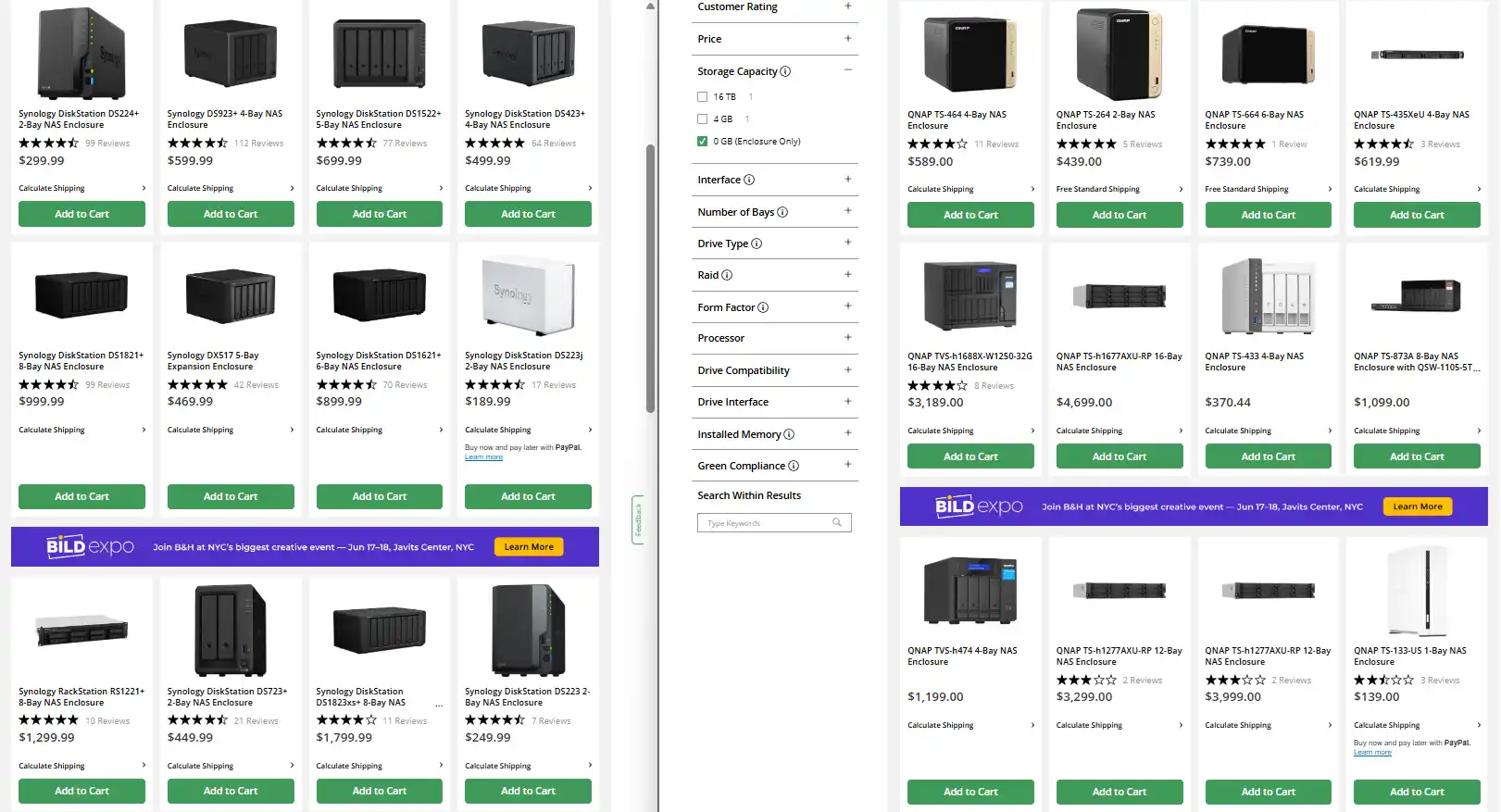
Synology DS925+ vs QNAP TS-464 – Hardware Specifications
When placing the 2025 Synology DS925+ alongside the 2022/2023 QNAP TS-464, one might expect the newer model to clearly dominate in every area. But hardware comparisons in the NAS market are rarely so simple. While both units are aimed at tech-savvy home users and small businesses looking for reliable, always-on storage solutions, their approaches to hardware—and the user needs they prioritize—are noticeably different. The DS925+ emphasizes streamlined performance, reduced noise, and integration within Synology’s tightly managed ecosystem. The QNAP TS-464, meanwhile, leans into raw hardware flexibility, DIY expandability, and a more open feature set for power users. Below is a detailed hardware breakdown of both NAS devices, showing where each shines and where compromises were made.
| Category | Synology DS925+
|
QNAP TS-464
|
Advantage / Notes |
|---|---|---|---|
| CPU Model | AMD Ryzen V1500B | Intel Celeron N5105 | Different architectures; depends on workload |
| CPU Cores / Threads | 4 Cores / 8 Threads | 4 Cores / 4 Threads | DS925+ has more threads |
| CPU Frequency | 2.2 GHz | 2.0 GHz (base) / 2.9 GHz (turbo) | TS-464 has higher clock speeds |
| Architecture | 64-bit | 64-bit | – |
| Hardware Encryption Engine | Yes | Yes | – |
| Memory (Pre-installed) | 4 GB DDR4 ECC SODIMM | 4 GB DDR4 non-ECC SODIMM | DS925+ uses ECC memory |
| Total Memory Slots | 2 | 2 | – |
| Max Memory Capacity | 32 GB (2x 16 GB ECC) | 16 GB officially, 32 GB unofficially | DS925+ officially supports more RAM |
| Drive Bays | 4 | 4 | – |
| Max Drive Bays (with Expansion) | 9 (DX525) | Up to 8/12/16 (TL-D800S or TL-D1600S) | TS-464 supports more total drives |
| M.2 Drive Slots | 2 x NVMe (cache only, unless you use Synology SSDs) | 2 x NVMe (cache or storage) | TS-464 offers more flexibility |
| Supported Drive Types | Synology-only verified HDD/SSD | Full third-party drive compatibility | TS-464 supports Seagate, WD, Toshiba, Kingston, Samsung, etc. |
| Hot Swappable Drives | Yes (SATA only) | Yes (SATA only) | – |
| LAN Ports | 2 x 2.5GbE | 2 x 2.5GbE | – |
| USB Ports | 2 x USB 3.2 Gen 1 | 2 x USB 3.2 Gen 2 Type-A | TS-464 has faster and more versatile ports |
| Expansion Port Type | USB Type-C (for DX525 only) | USB Type-C / USB-A (for TL & TR series) | TS-464 supports more expansion chassis |
| PCIe Slot | None | 1 x PCIe Gen3 x2 | TS-464 allows 10GbE or AI/GPU card upgrades |
| Dimensions (HxWxD) | 166 x 199 x 223 mm | 168 x 170 x 226 mm | Virtually the same size |
| Weight | 2.26 kg | 2.18 kg | TS-464 is slightly lighter |
| System Fans | 2 x 92mm | 1 x 120mm | DS925+ may offer better airflow; TS-464 is quieter |
| Fan Modes | Full-Speed, Cool, Quiet | Smart Fan Control | Comparable flexibility |
| LED Brightness Control | Yes | Yes | – |
| Power Recovery | Yes | Yes | – |
| Noise Level (Idle) | 20.5 dB(A) | 18.6 dB(A) | TS-464 is quieter |
| Power Supply | 100W External Adapter | 90W External Adapter | TS-464 is more power efficient |
| Power Consumption (Access / Hibernate) | 37.91W / 12.33W | 26.08W / 9.48W | TS-464 uses less power |
| BTU (Access / Hibernate) | 129.27 / 42.05 | 89.03 / 32.38 | TS-464 generates less heat |
| Operating Temp | 0°C to 40°C | 0°C to 40°C | – |
| Storage Temp | -20°C to 60°C | -20°C to 70°C | TS-464 is rated for slightly higher extremes |
| Humidity | 5% to 95% RH | 5% to 95% RH | – |
| Warranty | 3 years (extendable to 5) | 3 years (extendable with license or bundle) | – |
The DS925+ delivers a refined hardware experience out of the box, with its newer AMD Embedded Ryzen V1500B 4 Core/ 8 thread processor, dual 2.5GbE ports for faster LAN connectivity, and modern I/O including USB-C. It features two M.2 NVMe slots (for cache only, unless you use the Synology SNV3400 drives from Synology), dual memory slots supporting up to 32GB of ECC DDR4 RAM, and a compact metal chassis designed for quiet, efficient operation. It also runs cooler and quieter than many of its rivals, making it an ideal fit for environments where noise levels matter—such as living rooms, home studios, or small offices. This makes the DS925+ a “plug-and-play” NAS with premium internal components and minimal need for user intervention.
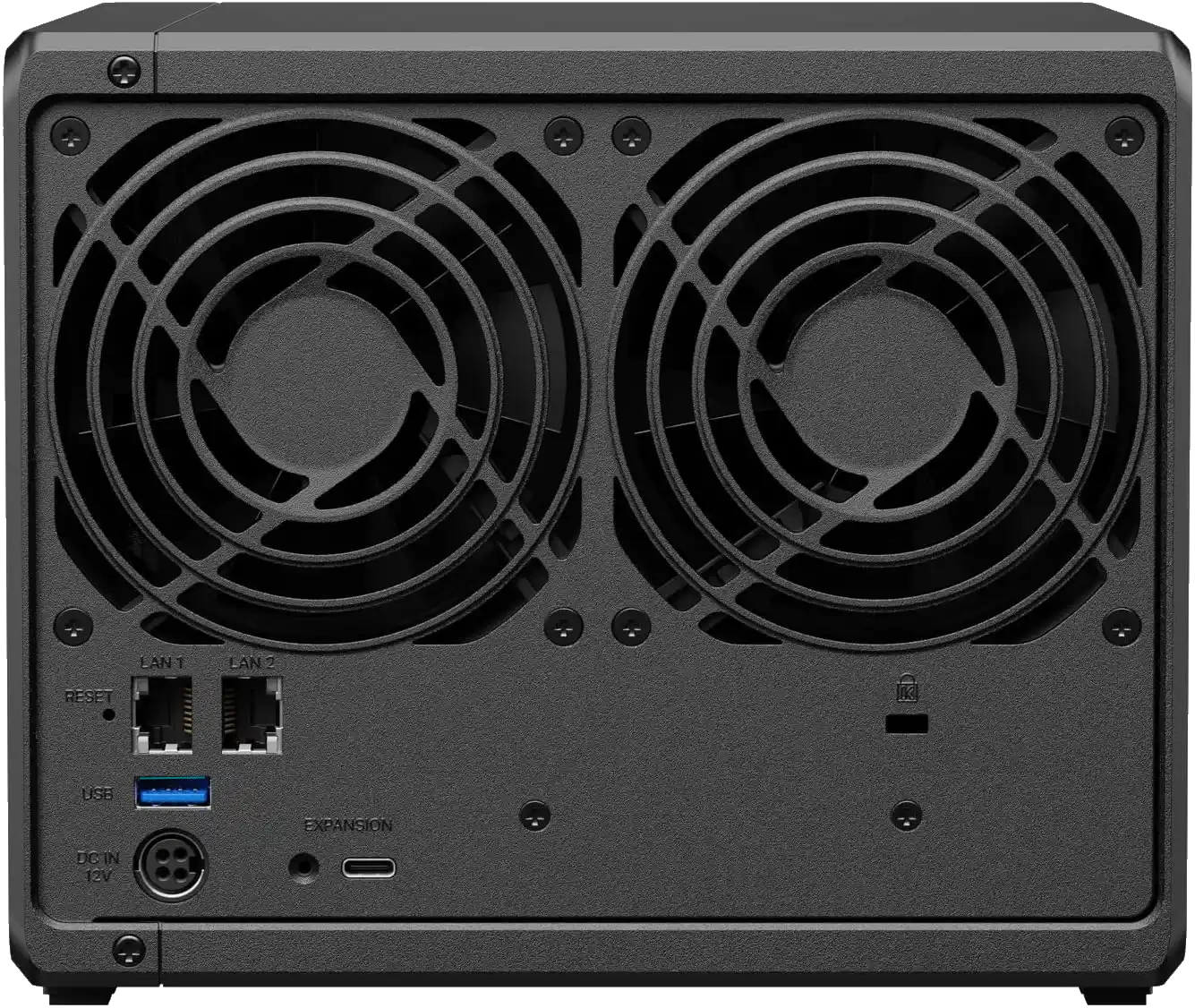 |
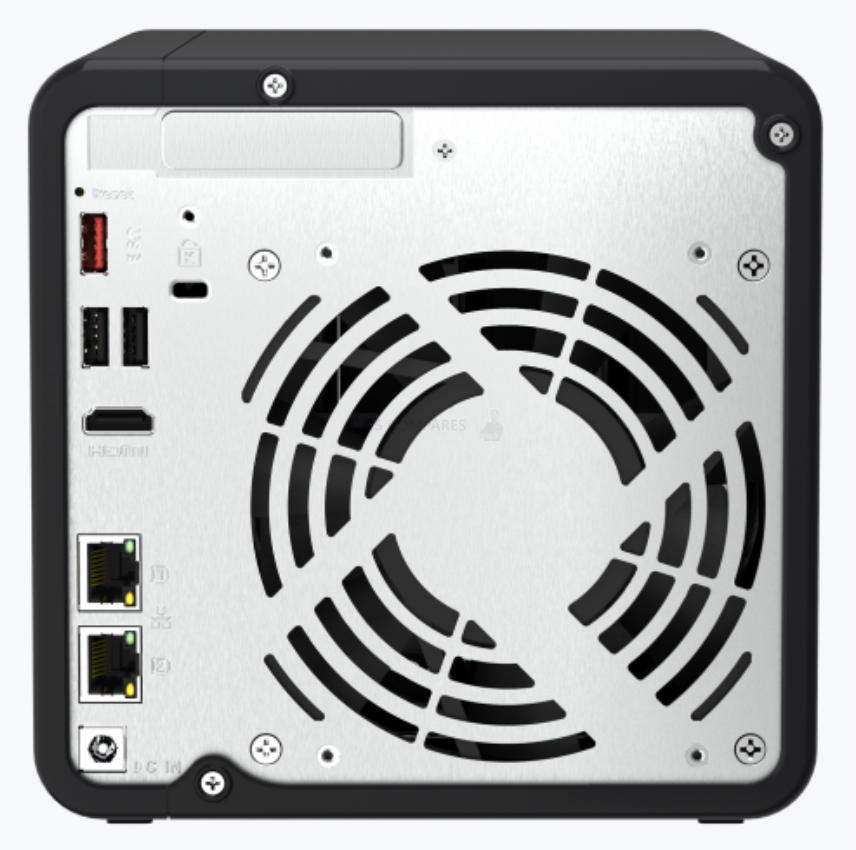 |
By contrast, the QNAP TS-464 takes a more modular, expandable approach. Powered by the Intel Celeron N5105/N5095 CPU (a quad-core processor with integrated graphics, but only 4 threads), it offers HDMI 2.0 output, two M.2 PCIe Gen3 x1 slots (which can be used for either caching or storage pools), and a PCIe Gen3 x2 slot for optional 10GbE or more M.2s, USB expansion, or even GPU cards. QNAP also includes dual 2.5GbE ports, putting it on par with the DS925+ in terms of network speed, but it edges ahead in overall hardware adaptability. Want multimedia output via HDMI? QNAP has it. Want to add NVMe storage pools or real-time transcoding? QNAP supports that too. That said, the TS-464 is based on a slightly older CPU architecture, lacks ECC memory support, and typically generates more fan noise under load. Additionally, its OS and ecosystem are broader in scope but often require more manual setup. Ultimately, the DS925+ is purpose-built for those who prioritize a quiet, polished, and simplified experience with modern performance. The TS-464, on the other hand, remains an excellent choice for users who prefer control, multimedia support, and greater hardware flexibility. Choosing between them largely depends on whether you value Synology’s stability and turnkey design, or QNAP’s freedom and potential.
AMD V1500B vs Intel N5105 – CPU Specifications (Synology DS925+ vs QNAP TS-464)
In any NAS system, the processor plays a pivotal role in determining the scope of functionality—whether it’s managing multiple concurrent users, running virtual machines, powering AI-driven applications, or simply handling encrypted transfers and background tasks efficiently. The Synology DS925+ and the QNAP TS-464 take noticeably different approaches in this regard. The DS925+ features the AMD Ryzen Embedded V1500B, a server-grade SoC designed for sustained multi-threaded workloads. The TS-464, on the other hand, runs on the Intel Celeron N5105, a more consumer-oriented chip that prioritizes integrated multimedia support and power efficiency. While both CPUs are quad-core, their architecture, instruction set, and target use cases diverge sharply—affecting not only raw processing, but also the capabilities unlocked within DSM and QTS/QuTS, respectively.
| Category | AMD Ryzen V1500B
|
Intel Celeron N5105
|
Advantage / Notes |
|---|---|---|---|
| Architecture | Zen (1st Gen) | Tremont (10nm) | N5105 uses newer fabrication process |
| Core / Thread Count | 4 Cores / 8 Threads | 4 Cores / 4 Threads | V1500B has SMT (hyperthreading) support |
| Base Clock Speed | 2.2 GHz | 2.0 GHz | V1500B slightly faster base |
| Boost Clock Speed | N/A (fixed clock) | Up to 2.9 GHz | N5105 has dynamic boost for single-thread performance |
| TDP (Thermal Design Power) | 16W | 10W | N5105 is more power efficient |
| L2 Cache | 2 MB | 1.5 MB | V1500B has more L2 cache |
| L3 Cache | 4 MB | 4 MB | Same |
| Integrated Graphics | None | Intel UHD Graphics (24 EUs @ 800 MHz) | N5105 supports HDMI, video decoding, and light GPU tasks |
| PCIe Version | PCIe 3.0 | PCIe 3.0 | – |
| Max Memory Supported | 32 GB ECC DDR4 | 16 GB officially (32 GB unofficially) | V1500B supports higher, ECC-capable memory |
| Memory Type | DDR4 ECC | DDR4 / LPDDR4x (non-ECC) | V1500B supports ECC, better for critical NAS use |
| Virtualization Support | Yes (AMD-V) | Yes (VT-x, VT-d) | Both CPUs support virtualization features |
| AES-NI (Encryption) | Yes | Yes | Both support hardware encryption |
| Target Use Case | Embedded systems / Business NAS | Low-power desktops / SMB NAS / IoT | V1500B is more server/NAS-specific |
| Release Year | 2020 | 2021 | N5105 is newer |
In terms of raw specs, the V1500B offers 4 cores and 8 threads with a base clock of 2.2GHz and support for ECC memory—a key advantage for mission-critical environments. This CPU is built for multitasking and thrives in scenarios involving virtual machines, container services, and intensive file indexing or backup operations. As a result, the DS925+ supports up to 8 concurrent virtual machines, 8 virtual DSM instances, and higher thresholds for connected users across Synology apps. It is better suited to offices or power users who rely on services like Synology Office, Drive, or Surveillance Station running in tandem. The system handles up to 150 Synology Chat users, 80 Office users, and 80 Drive users, offering excellent multitasking performance with low overhead.
The QNAP TS-464’s Intel N5105 is a 10nm Jasper Lake processor, also quad-core but without hyper-threading and with a slightly lower base clock (2.0GHz). However, it includes integrated Intel UHD Graphics, giving it one key advantage the DS925+ lacks: hardware-accelerated video transcoding via QNAP’s own QuMagie, Video Station, and especially Plex Media Server with support for on-the-fly 1080p and 4K decoding when paired with proper client-side licensing. This makes the TS-464 ideal for multimedia-heavy environments. Beyond media, the N5105 powers QTS and QuTS hero with access to QNAP’s broader and often more modular ecosystem. This includes Hybrid Backup Sync (HBS 3) for unified backup and disaster recovery, QuDedup for deduplicated snapshot replication, QVR Elite and QVR Pro for professional-grade surveillance (supporting multiple IP camera licenses natively), and AI Core features like face recognition and event detection when paired with the QuMagie or QVR Human apps. The TS-464 also supports Virtualization Station, enabling users to run lightweight Linux or Windows VMs with direct passthrough access to USB or PCIe devices, and Container Station, which offers both Docker and LXC container compatibility with GPU passthrough for NPU-based AI inference workloads. Thanks to the included PCIe Gen 3 x2 slot, the system supports optional upgrades like 10GbE NICs, QM2 expansion cards (for M.2 SSD or additional 2.5GbE/10GbE ports), or even Wi-Fi 6 cards, something entirely absent in the DS925+. Additionally, QNAP allows direct output to an external display via HDMI 2.0, enabling standalone use of HD Station apps like Chrome, LibreOffice, Kodi, and even Linux desktop environments — a feature highly prized in HTPC and security NVR deployments. Users can leverage Linux Station to run full Ubuntu VMs locally, or install Ubuntu Core through the App Center for custom development or edge AI inference scenarios.
Taken together, the TS-464 may not support the same high virtual machine/user count as the DS925+, but it compensates with a broader set of integrated appliances catering to power users, home labs, edge AI, and media-heavy deployments. It’s a more “tinker-friendly” platform, favoring flexibility and breadth over centralized system control and vertical integration. If you need an appliance that works across entertainment, security, and hybrid cloud workflows, with room for add-on functionality via hardware or apps, the TS-464 is hard to beat for the price. That said, the Synology DS925+ ultimately offers greater headroom for enterprise workflows, heavier VM usage, and large-scale hybrid deployments. It sacrifices media transcoding and graphical acceleration, but gains a server-class CPU that ensures consistent performance under heavier load conditions. Meanwhile, the TS-464 excels in edge-case versatility, offering more multimedia flexibility and richer expansion potential via PCIe. If your priorities lie in business-class performance, ECC memory support, and robust multi-user capacity, the DS925+ is the clear winner. But for media streaming, home lab tinkering, and a wider hardware feature set, the TS-464 remains a very compelling alternative.
Synology DS925+ vs QNAP TS-464 – Software Specifications
When it comes to NAS platforms, hardware is only half the story—what truly determines a system’s long-term value is the strength, maturity, and flexibility of its software. Synology’s DSM (DiskStation Manager) and QNAP’s QTS/QuTS Hero are two of the most advanced NAS operating systems available today, offering extensive suites of services for backup, virtualization, hybrid cloud, media streaming, and AI-assisted surveillance. But while both OS platforms cover similar ground, their design philosophies, application depth, and supported workloads differ substantially. The Synology DS925+ and QNAP TS-464, though comparable in price and both aimed at prosumers and SMBs, unlock very different software experiences depending on the deployment goals—be it centralized IT infrastructure, media-rich home labs, or container-based edge computing.

With the DS925+, Synology leans into its strength in unified management and vertical integration. DSM 7.2 is optimized for reliability, simplicity, and scalability within Synology’s ecosystem. The DS925+ supports up to 8 virtual machines and 8 Virtual DSM instances through Virtual Machine Manager, offers extensive group and user quotas, and enables full integration with Synology’s cloud services (such as Synology C2 Backup, C2 Identity, and Hybrid Share). Its higher hardware ceiling allows for more active users: 150 on Synology Chat, 80 on Synology Drive and Office, and up to 8 simultaneous VPN connections. Backup capabilities are similarly robust, with a higher threshold of shared folder sync tasks and superior support for incremental snapshot replication. Surveillance Station on the DS925+ supports up to 40 IP cameras and benefits from reduced CPU overhead during continuous recording, even while handling concurrent backup or media indexing operations. DSM’s elegant UI, consistent updates, and tightly integrated packages make it ideal for organizations that value centralized IT administration and long-term platform stability.
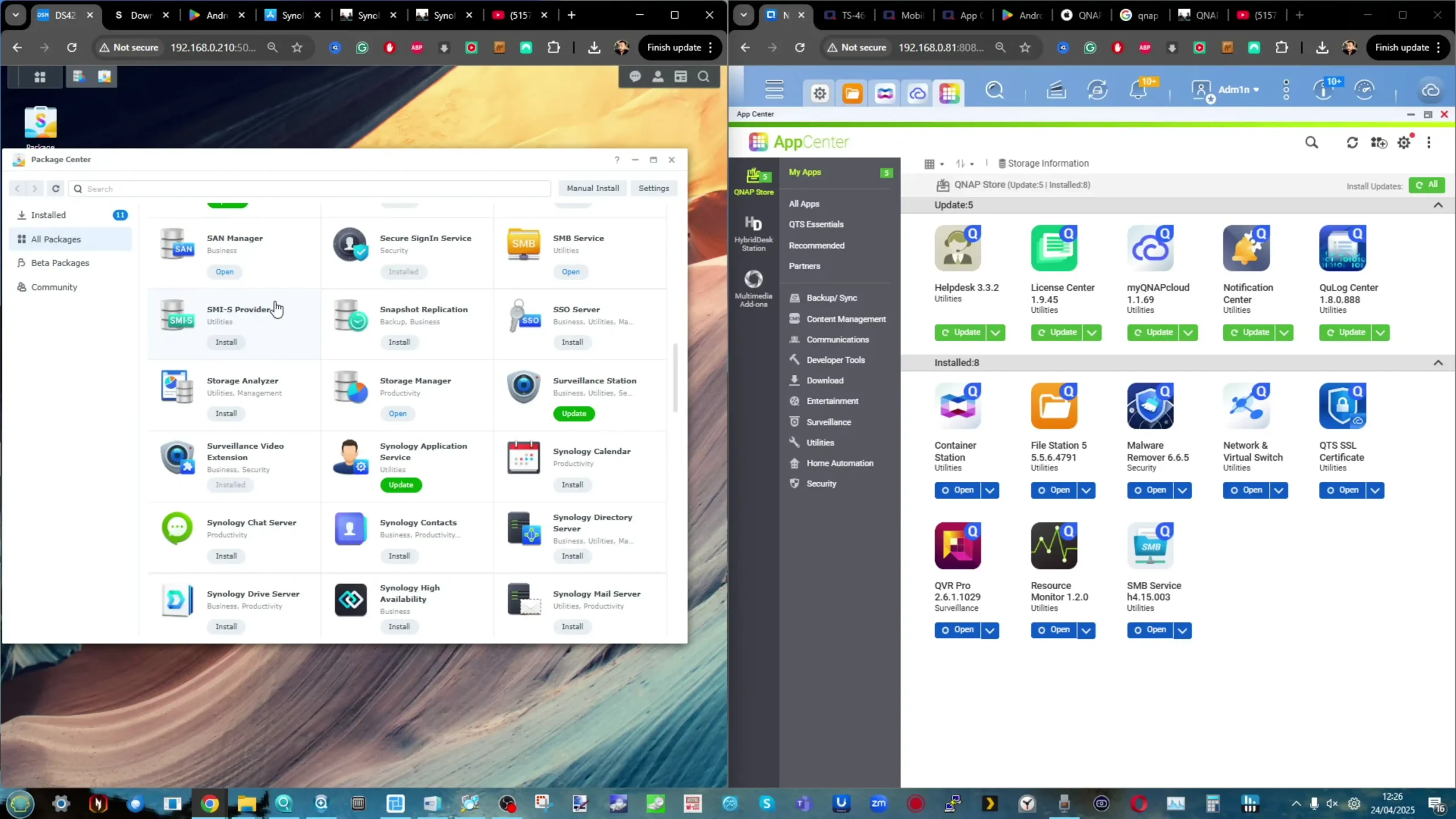
On the other hand, the QNAP TS-464 running QTS 5 or QuTS Hero offers a more open and modular software ecosystem. While the Intel N5105 CPU imposes lower multitasking ceilings than the V1500B, QNAP compensates with a broader set of feature-specific applications and customization paths. The TS-464 supports virtualization through Virtualization Station (for VMs) and Container Station (for Docker + LXC), and unlike the DS925+, can output video directly via HDMI 2.0—allowing the NAS to act as a standalone Linux desktop, NVR, or HTPC via HybridDesk Station. QNAP also differentiates itself with Hybrid Backup Sync (HBS3), which enables multi-destination sync, deduplicated backup via QuDedup, and real-time disaster recovery tools not found in DSM. QVR Pro and QVR Elite offer an expansive surveillance suite with optional AI-powered analytics (e.g., face recognition, people counting) when paired with compatible QNAP AI apps. The inclusion of ZFS with QuTS Hero (an optional OS for the TS-464) enables inline compression, self-healing file systems, and block-level snapshots, which can be critical for data integrity in business scenarios.
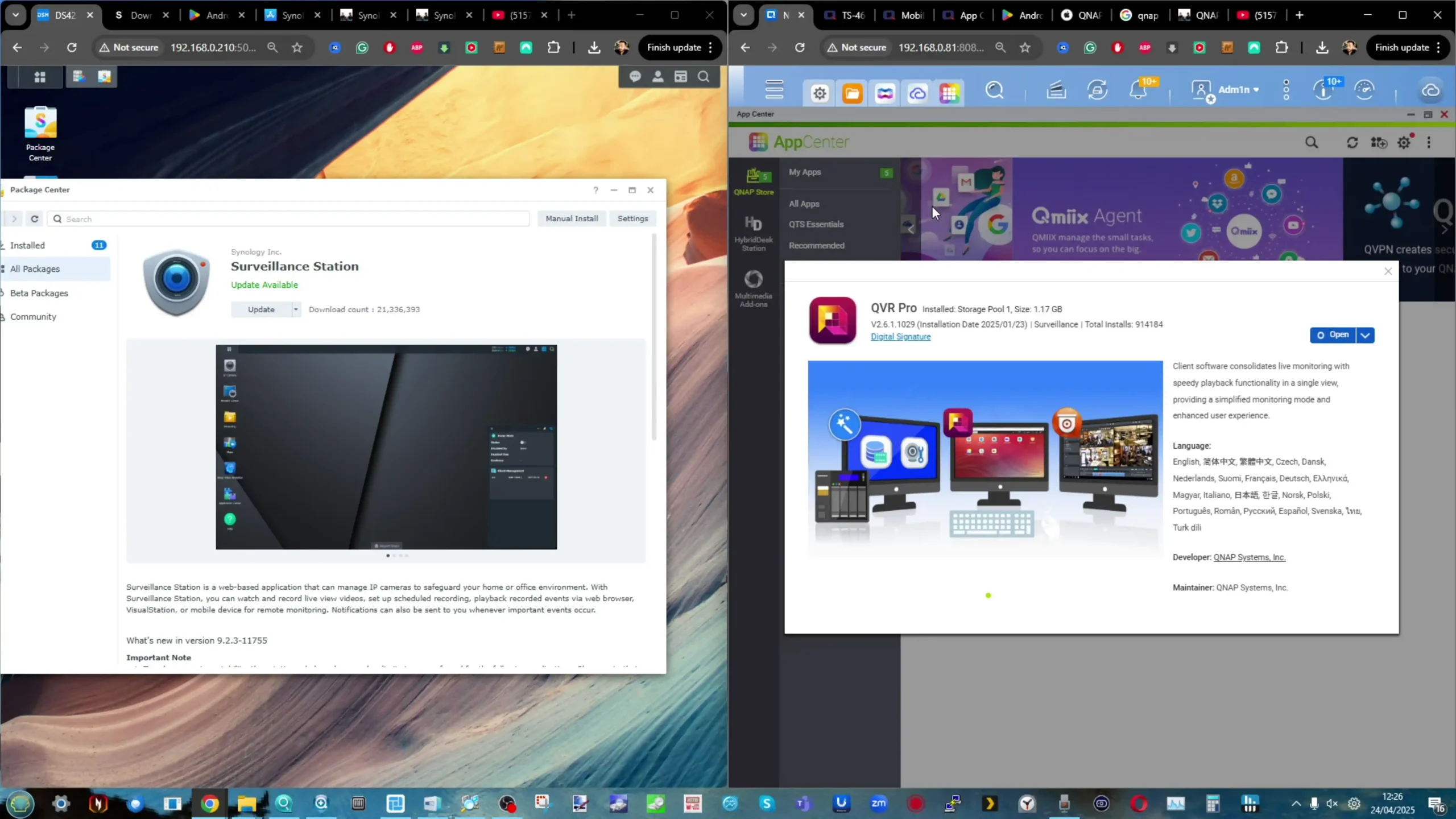
QNAP also encourages expansion through its App Center, which includes over 150+ native and third-party apps, from Node.js and GitLab to Home Assistant, Ubuntu Station, and even Mattermost for self-hosted chat. While the system supports fewer concurrent users and VMs than the DS925+, its strength lies in feature breadth and system-level flexibility. Add-ons like 10GbE NICs, QM2 SSD accelerators, or Wi-Fi 6 cards via PCIe further extend its versatility, especially for hybrid edge workloads or multi-role deployments that evolve over time. In short, the Synology DS925+ is designed for administrative simplicity and long-term scaling, excelling in consistent performance across multi-user deployments with deep DSM integration. The QNAP TS-464, meanwhile, is a powerful sandbox for customization, offering greater freedom, multimedia functionality, and third-party integration—at the cost of some operational polish and software limits. Choosing between them depends on whether your priorities lie in predictable enterprise-grade execution or a more adaptable, feature-dense platform.
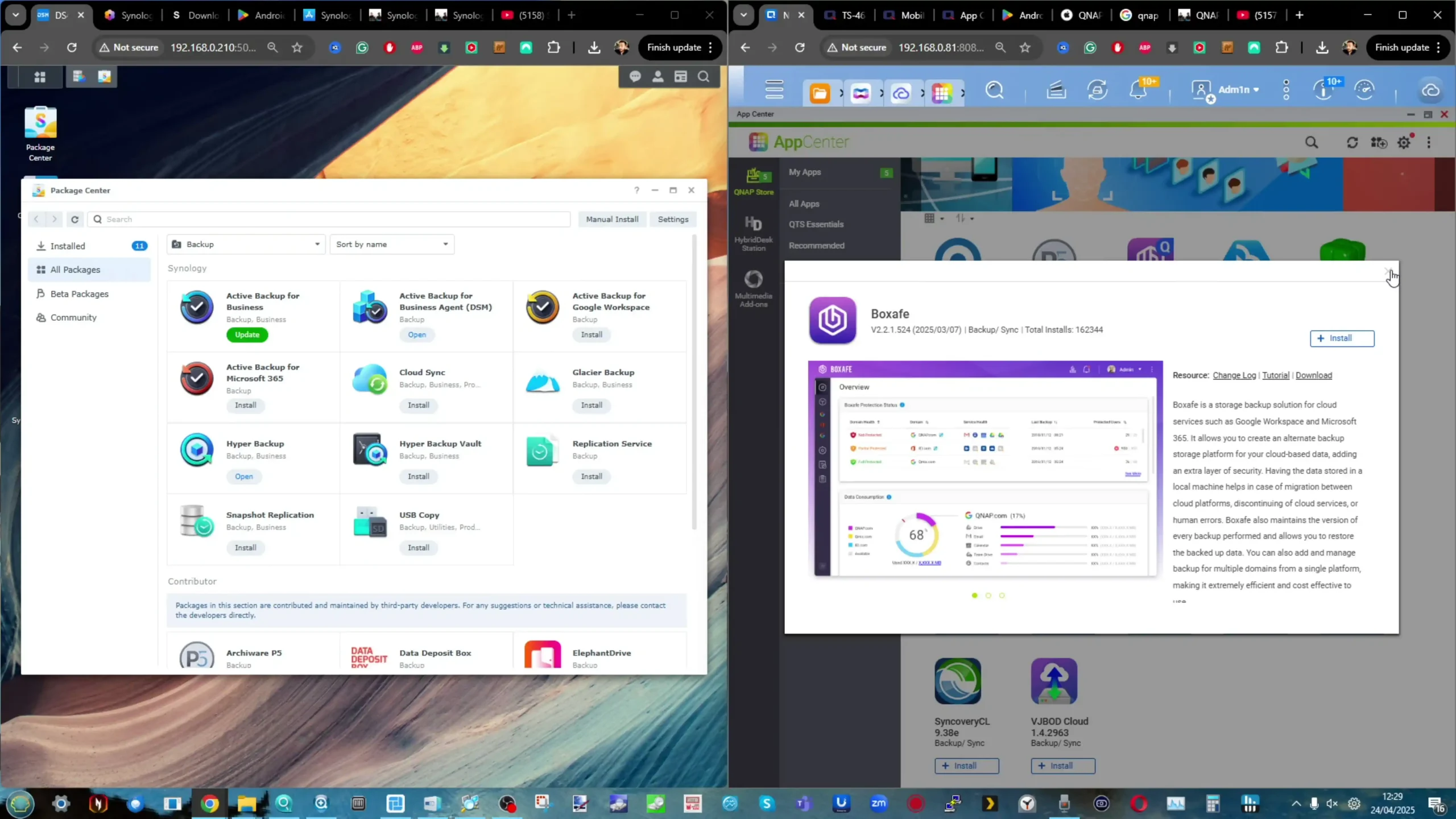
Synology DS925+ vs QNAP TS-464 – Hard Drive and SSD Compatibility
In 2025, Synology has taken its most aggressive step yet toward locking down hardware compatibility, and nowhere is this more evident than in the DS925+. Following years of gradual restrictions—starting with warnings for unverified drives and progressing to default white-listing only Synology-branded media—the DS925+ now represents a firm line in the sand. At the time of writing, this system will not allow DSM initialization if it detects hard drives or SSDs that are not officially listed on Synology’s compatibility list. This list includes exclusively Synology HAT5300/HAT3310 HDDs and SAT5200 SSDs, with no third-party Seagate, WD, Toshiba, Samsung, or Kingston media currently supported. Regardless of drive quality or performance, unsupported models will be outright blocked during system setup. While Synology claims this guarantees optimal reliability and performance within DSM 7.2, the move drastically reduces flexibility for users and integrators alike.
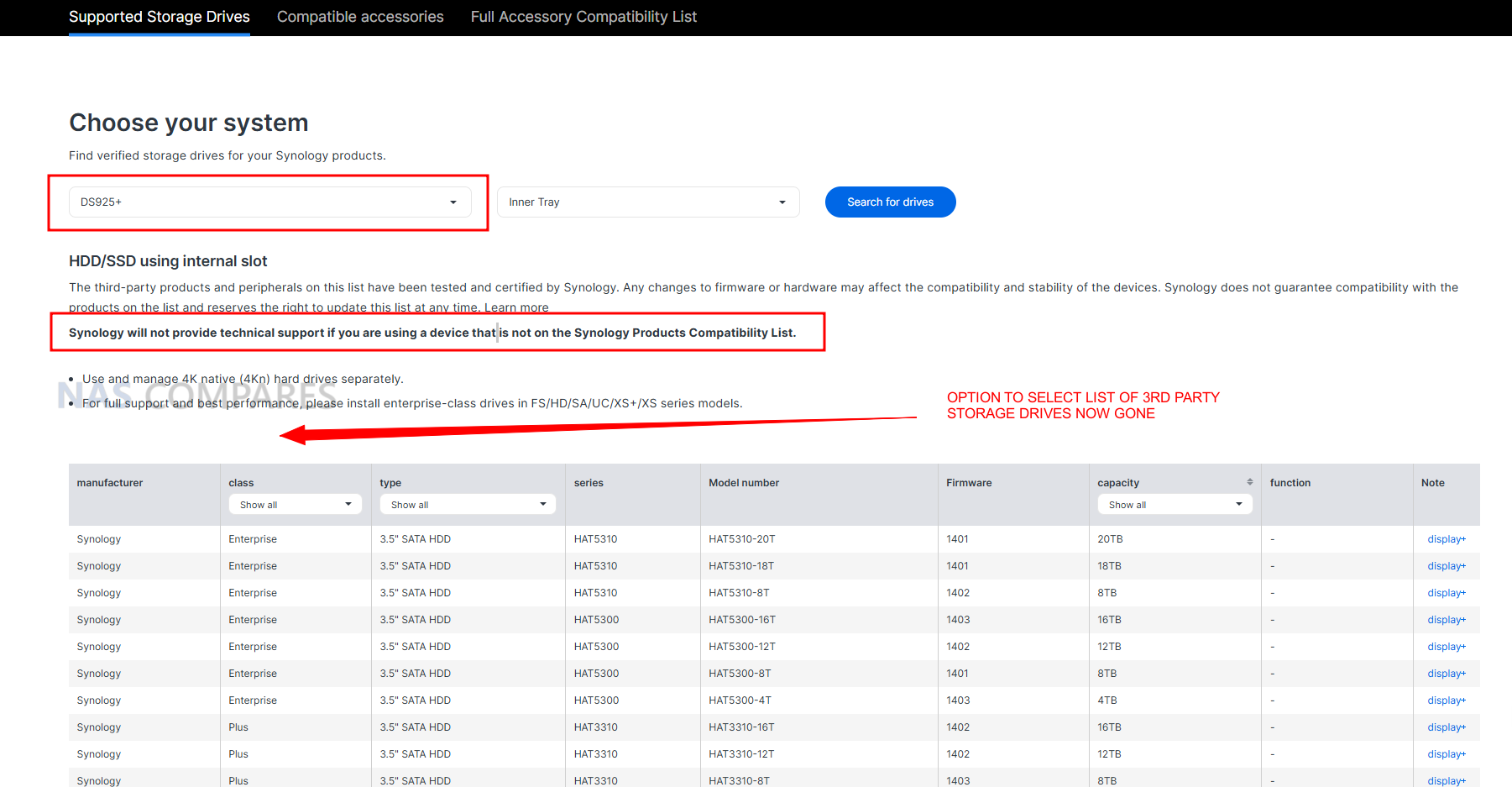
In stark contrast, the QNAP TS-464 embraces an open compatibility philosophy. It supports virtually all major consumer and enterprise drives—from Seagate IronWolf and Exos, to WD Red, Red Plus, and Ultrastar, as well as Toshiba N300/X300 and Samsung/Kingston SSDs—up to 24TB per drive (or higher as of late 2025). QNAP also maintains a regularly updated compatibility list, but crucially, this list is advisory rather than mandatory. Users can install any 3.5″ or 2.5″ SATA HDD/SSD, and as long as it meets the physical and electrical standards, the TS-464 will initialize without issue. This means integrators, home users, or small businesses can reuse existing drives or select from the most cost-effective options in their region—something that’s increasingly difficult to do on newer Synology units. Moreover, QNAP allows mixing and matching of drive brands and capacities within the same storage pool (especially under QuTS hero’s ZFS environment), giving users granular control over redundancy, performance tuning, and cache layering with non-proprietary M.2 NVMe SSDs. This openness also applies to QNAP expansion units, many of which continue to work even with completely mixed-brand storage configurations—something Synology’s newer expansion policies have started to restrict.
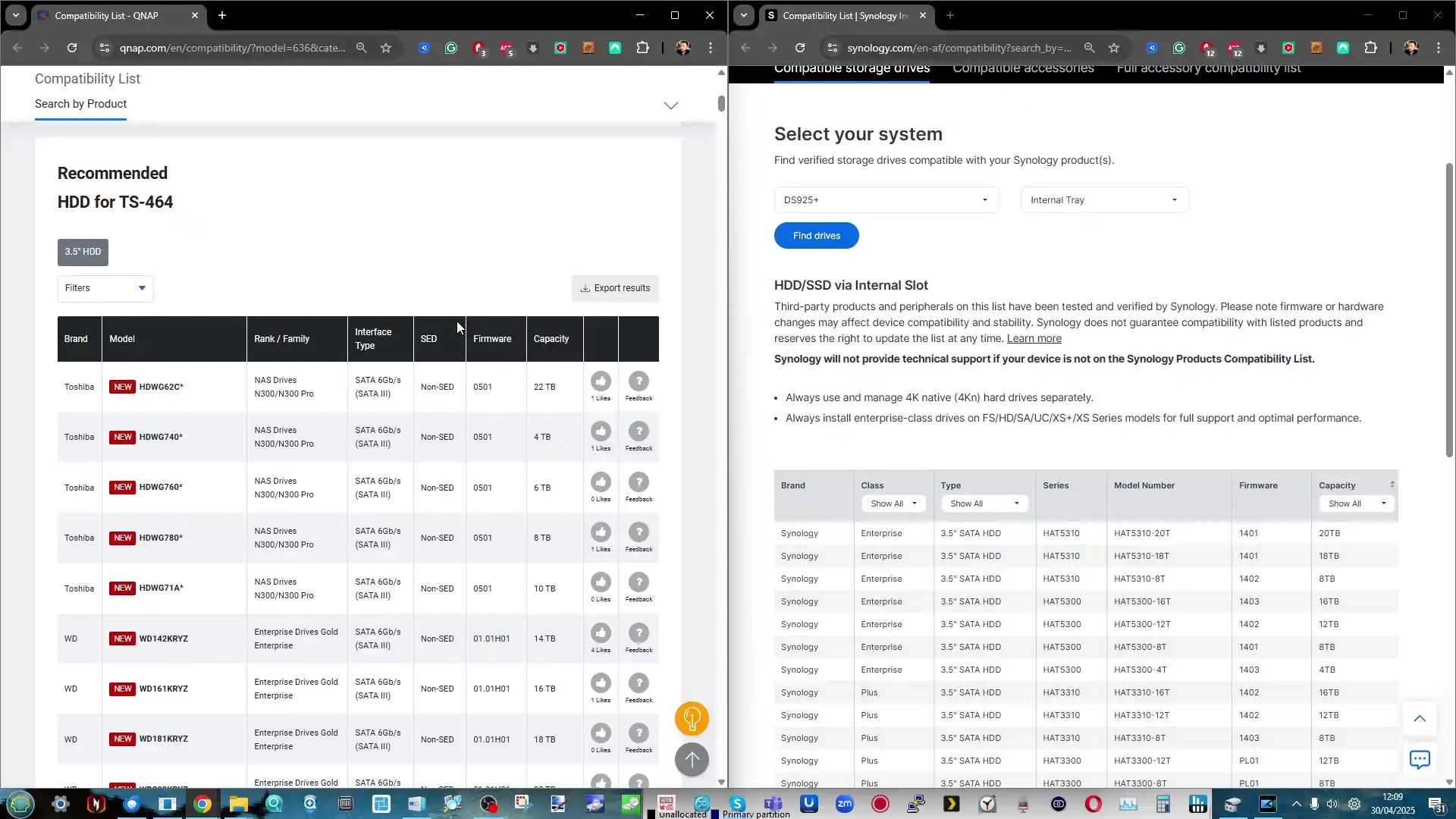
For users in regions where Synology-branded media is expensive, hard to find, or simply not justified for non-critical applications, this policy shift on the DS925+ can be a deal-breaker. It positions the system closer to an appliance model, where Synology controls not only the hardware and software, but the storage medium itself. While that vertical integration may improve long-term reliability for some enterprise users, it’s difficult to reconcile with the broader DIY NAS community that values choice and modularity. Ultimately, this creates a philosophical divide: QNAP remains open, modular, and adaptable, trusting users to make informed decisions about their storage media. Synology, in contrast, is consolidating control, with the DS925+ exemplifying a move toward a closed ecosystem—potentially alienating users who previously praised DSM for its balance of simplicity and flexibility. Prospective buyers need to weigh not just performance and features, but how tightly they want to be tied to a single vendor’s hardware roadmap.
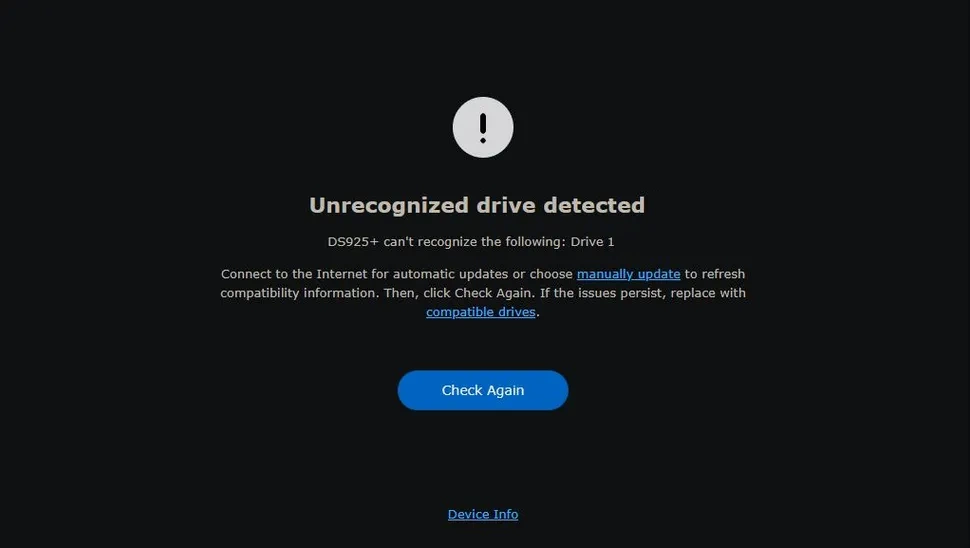
Synology DS925+ vs QNAP TS-464 NAS – Which Should You Buy?
The Synology DS925+ is a 2025 refresh designed with clear intent: push performance, tighten control, and streamline the out-of-box experience. In contrast, the QNAP TS-464—released in late 2022—is a Swiss Army knife of NAS flexibility, packed with customization options, open compatibility, and enough horsepower to meet the needs of both power users and small business deployments. Choosing between them ultimately comes down to what kind of NAS experience you’re after: a controlled, polished, and tightly integrated environment, or an open, adaptable, and hardware-friendly platform. On raw performance, the DS925+ has the edge. Its quad-core, 8-thread AMD V1500B CPU delivers higher throughput for multitasking, virtual machines, and heavier concurrent services, and DSM’s user/service thresholds are notably higher as a result. Add in dual 2.5GbE ports by default, and it’s clearly a step ahead of the DS923+ predecessor 1GbE-only base configuration, and you are looking at a healthy upgrade in several ways in this refresh. However, QNAP claws back ground with its PCIe Gen3 x2 slot, allowing 10GbE upgrades, Wi-Fi cards, and even GPU acceleration in select use cases—something Synology removed entirely from the DS925+. In QNAP’s favor is also its support for real-time hardware transcoding, HDMI 2.0 video output, and direct-attached monitor access—making it a better fit for media-centric environments where local playback, Plex, or Kodi usage matters.
|
|

QNAP TS-464 NAS |
||
|
Check Amazon in Your Region for the Synology DS925+ NAS |
Check B&H for the Synology DS925+ NAS |
Check Amazon in Your Region for the QNAP TS-464 NAS |
Check B&H for the QNAP TS-464 NAS |
But perhaps the most significant dividing line is drive compatibility. The DS925+ will only initialize DSM with Synology-validated drives—locking out nearly all third-party HDDs and SSDs unless explicitly approved. This hardline stance means limited flexibility for users wanting to build using existing drives or regional market alternatives. Meanwhile, the TS-464 supports virtually all consumer and enterprise drives, from Seagate to Toshiba to Kingston, giving users total control over their storage budget and deployment roadmap. This open-ecosystem approach extends to M.2 NVMe usage too, where QNAP allows storage pool creation, caching, and tiering with off-the-shelf modules, while Synology restricts pool creation to only their branded NVMes. If you’re an IT administrator, content creator, or SMB looking for a polished, performance-forward NAS and you’re fully on board with Synology’s ecosystem—including its branded drives—then the DS925+ offers a streamlined, high-ceiling experience with excellent multitasking potential and cleaner UI/UX polish under DSM 7.2. But if you’re someone who values flexibility, upgrade paths, media support, or simply wants to control your storage choices without vendor lock-in, the QNAP TS-464 is an incredibly compelling alternative—offering strong performance for its price, an open architecture, and a deeper toolbox under QTS/QuTS Hero.

NAS Solutions |

NAS Solutions |
| + Better Software (In almost every respect!)
+ Much Better Global Support Presence + More business desirable + Larger Range of solutions – Compatibility restrictions on HDD and Upgrades More and more – Underwhelming hardware (comparatively) |
+ Better Hardware for Price
+ Wider Variety of Solutions and Hardware Profiles + Supports ZFS and/or EXT4 (with ZFS platform now available on latest Intel Celeron Systems) + Wide accessory range and compatibility – Software can often feel inconsistent – Hit by Security Issues if the past |
|
Check Amazon By Clicking Below: |
Check Amazon By Clicking Below: |
The Synology DS925+ is the better plug-and-play NAS for prosumers and SMBs who want a high-performance, low-maintenance experience—provided they’re comfortable buying into Synology’s tightly controlled ecosystem of software and storage hardware. On the other hand, the QNAP TS-464 remains the better choice for users who value flexibility, hardware freedom, and scalability—especially if media features, drive compatibility, or future upgrades are part of the plan. Ultimately, the DS925+ is the sharper tool, but the TS-464 is the more versatile one.
📧 SUBSCRIBE TO OUR NEWSLETTER 🔔🔒 Join Inner Circle
Get an alert every time something gets added to this specific article!
This description contains links to Amazon. These links will take you to some of the products mentioned in today's content. As an Amazon Associate, I earn from qualifying purchases. Visit the NASCompares Deal Finder to find the best place to buy this device in your region, based on Service, Support and Reputation - Just Search for your NAS Drive in the Box Below
Need Advice on Data Storage from an Expert?
Finally, for free advice about your setup, just leave a message in the comments below here at NASCompares.com and we will get back to you. Need Help?
Where possible (and where appropriate) please provide as much information about your requirements, as then I can arrange the best answer and solution to your needs. Do not worry about your e-mail address being required, it will NOT be used in a mailing list and will NOT be used in any way other than to respond to your enquiry.
Need Help?
Where possible (and where appropriate) please provide as much information about your requirements, as then I can arrange the best answer and solution to your needs. Do not worry about your e-mail address being required, it will NOT be used in a mailing list and will NOT be used in any way other than to respond to your enquiry.

|
 |
What is QNAP Planning for 2026? Round Up of the QNAP 2025/2026 Event in London
2x 10GbE to USB4 Adapter - DO YOU NEED THIS?
New Gl.iNet Beryl 7, Comet 5G SIM KVM and Flint 3e Value Router Revealed
NEW UGREEN DXP4800 PRO and DXP4800S NAS REVEALED
NanoKVM Pro Review - SO, SO CLOSE TO PERFECT...
Jonsbo N6 DIY NAS Case - NINE BAYS????
Access content via Patreon or KO-FI





Discover more from NAS Compares
Subscribe to get the latest posts sent to your email.



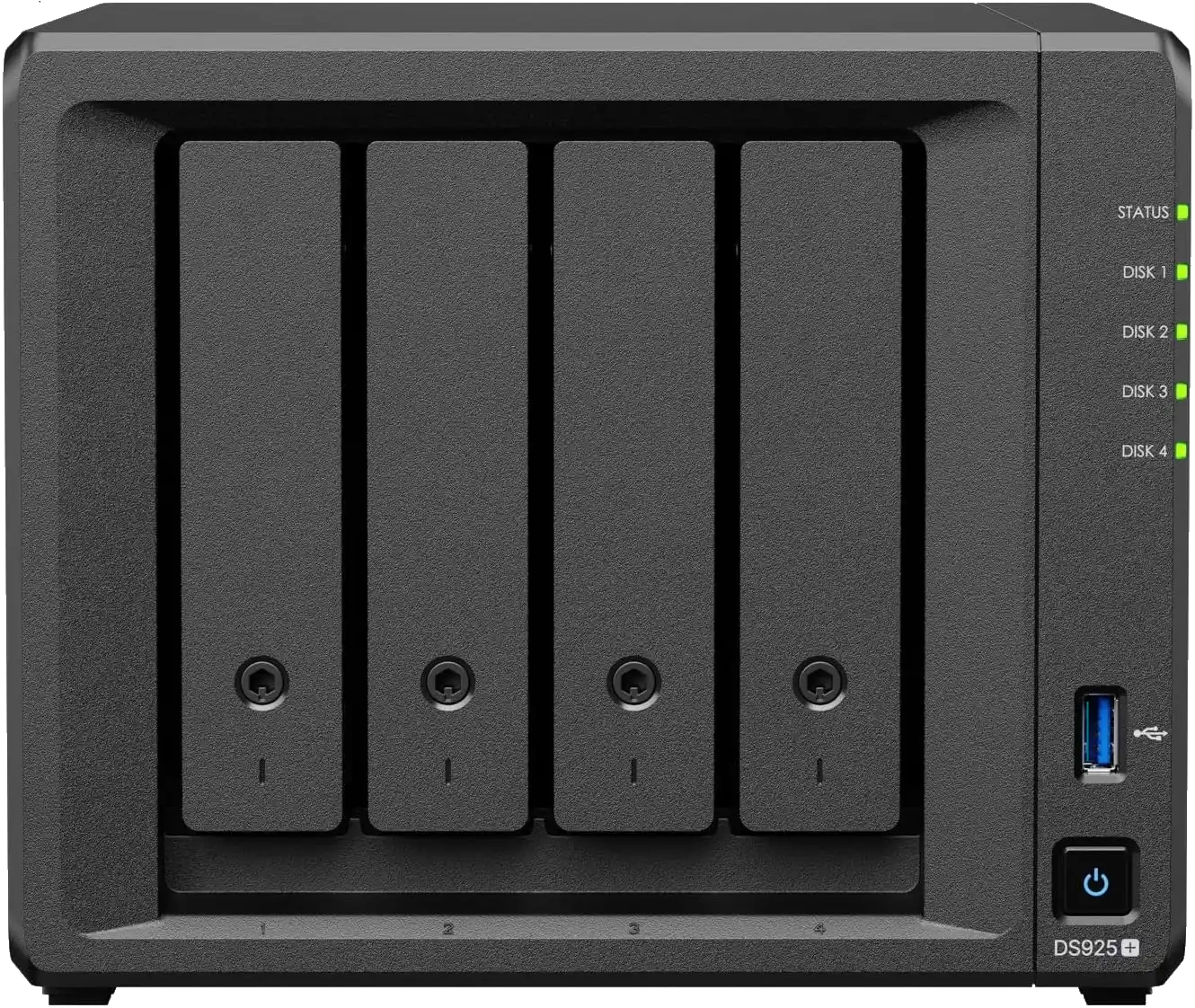






Mt ts-464 came with 8gb, slotted. Soni added 8.more.
REPLY ON YOUTUBE
I am not the most tech-savvy person but I’m looking for a NAS to host PLEX, photos, files, a VPN, and maaaaybe home surveillance. These are the two NAS setups I’ve been looking at pretty closely, so this video was VERY helpful.
While I’m drawn to the Synology software, the comments/reviews I’ve been seeing on multiple websites is that the drive compatibility is cruel and definitely raises the price. I think I’ll be purchasing the QNAP.
REPLY ON YOUTUBE
What is the current model of this same NAS? All the model numbers etc confuse the heck out of me.
For my media server needs I’d only be streaming 1080p content for 1-5 users maximum with 5 people streaming remotely being extremely rare. Streams would be to Plex App on devices like TVs, Firestick or Xbox.
Would I likely run into any issues or would I just be okay with this?
REPLY ON YOUTUBE
I’m doing a storage refresh project in my home lab, I’ve got 12TB WD Red Plus disks and and after consideration I went for QNAP TS-464. I really wanted to get Synology, but I can’t risk all this compatibility BS. So good luck Synology, you’ve lost yet another customer.
REPLY ON YOUTUBE
Moron customer ‘my synology is not working’
Synology support ‘is it the hard drive?’
Moron ‘no’
Support ‘are you sure? could it be the refurbished drives from a server farm you bought kinda cheap since you thought it was new?’
Moron exits the chat.
REPLY ON YOUTUBE
Moron customer ‘my synology is not working’
Synology support ‘is it the hard drive?’
Moron ‘no’
Support ‘are you sure? could it be the refurbished drives from a server farm you bought kinda cheap since you thought it was new?’
Moron exits the chat.
REPLY ON YOUTUBE
Moron customer ‘my synology is not working’
Synology support ‘is it the hard drive?’
Moron ‘no’
Support ‘are you sure? could it be the refurbished drives from a server farm you bought kinda cheap since you thought it was new?’
Moron exits the chat.
REPLY ON YOUTUBE
Moron customer ‘my synology is not working’
Synology support ‘is it the hard drive?’
Moron ‘no’
Support ‘are you sure? could it be the refurbished drives from a server farm you bought kinda cheap since you thought it was new?’
Moron exits the chat.
REPLY ON YOUTUBE
The 453e is also a good comparison here…
REPLY ON YOUTUBE
I was just looking for a couple of rackmount NAS when the news of Synology locking out third party drives came to light. I voted with my wallet and went QNAP. Absolutely loving the QNAP solution.
REPLY ON YOUTUBE
So are there any rumours about an updated QNAP TS-464? I’m close to buying a couple of 4-bay models but Synology is completely out of the question as their drives would add literally thousands more to the total cost.
REPLY ON YOUTUBE
As always, your comparison is great????, *but you are wrong on one point: The Cost is not at all similar, **_NO_** NAS is operated without disks.*
*❯ If both NAS have 4x 24TB, then the price difference (here in Switzerland) is about around €1000*
REPLY ON YOUTUBE
*Because Synology is driven by greed,* replaces standard applications overnight or even takes them out of service and only does work half-heartedly out of greed (e.g. Synology Active Backup for Business no longer updates itself automatically), *Synology is no longer a choice on principle.*
*We (a group of companies with 8 sister companies and 750 employees) have banned Synology because the company can no longer be trusted:*
*If Synology earns 100$ more per customer, Synology sells the customers.*
REPLY ON YOUTUBE
The key comparison I can’t find confirmation on is whether any competitor can match Synologyo’s drive mixing and matching.
Specifically, I’m on 4x 14TB drives, currently in my older Synolgoy. If I swap 2 of them out for 20TB drives, I know I’ll get that extra space right away and I can upgrade the other drives later when I need. I haven’t been able to _confirm_ I can do that on any other platform, which is the only real temptation to just stay on Synology now instead of potentially fully upgrading.
REPLY ON YOUTUBE
I’ve had my ds418 for several years. It’s been flawless…I wasn’t even using nas drives. Lol… Last year I upgraded to to nas iron wolf drives. I don’t do much with it. I Just back up from 2 pcs..and Google drive storage. The other day my raid 10 detected bad drive. I removed it. Wiped it. Tested it. Nothing wrong. Even synology test said healthy. I had to change the drive serial number and deactivate the drive then reinstall it. It worked. But that left a bad taste in my mouth moving forward. I have a feeling the new updates are going to slowly do this to my drives to force me to get new ones…I’m guessing of course. But why now all of a sudden drive issues after years of flawless activity.
REPLY ON YOUTUBE
I thought I heard information about Synology’s downgrading DSM to smg more basic, or is this wrong?
I think Synology may have missed a trick here, they could have first released pre loaded synology drives, similar to Beestation but multiple in a RAID config and with use to full DSM. This would seem great for first time users, and soften the blow for the non preloaded versions, perhaps selling them in a 0, 1, 2 or 4 HDD “value pack”. But in reality, most tech savvy ppl want whatever drives they want to work in a NAS
REPLY ON YOUTUBE
Of these two, QNAP is the only answer. I will not give my money to a company that vendor locks something as universal as a hard drive due to corporate greed.
REPLY ON YOUTUBE
A client has a huge Synology / Netapp storage farm and for the test lab we use cheaper desktop units. Recently tried some Seagate 24TB and were not detected in the desktop or rack mount systems. called Enterprise support and hinted that “QNAP look nice” and they applied a private fix and hey presto these Seagate 24TB drives are detected and can be used with warnings.
In our production we only use HAT drives on Synology. Netapp their drives and anything lying about seems to work so long as it’s SAS
REPLY ON YOUTUBE
I won’t buy Synology NAS ever again, Next one will either be TerraMaster or QNAP
REPLY ON YOUTUBE
I have to wonder if Synology would dare double-down at some point in the future and impose HDD restrictions retroactively on older units. It’s only a software switch, nothing more, so the code resides within all Synology NAS’s updated to the latest version of DSM.
Yes, it would likely be business suicide if they did, but companies have been known to be that arrogant in the past. How about Synology places a restriction on the replacement of drives in older units to only permit use of their own drives? I still think Sinology’s statement about reducing support issues with third-party drives is a smoke screen. Consider how many users they’ve had for the years their policy allowed third-party drives, and you’ll see what I mean.
Oh, BTW, I’ve heard mention of software updates for the AMD Ryzen based units until 2029. Is that coming from Synology or AMD? If this is a Synology move, then this annoys me. Imposing software obsolescence on a unit I would have owned for just seven years is outrageous.
REPLY ON YOUTUBE
I won’t ever be buying a Synology product again, and I bet I’m not the only one here.
REPLY ON YOUTUBE
QNAP OS sucks!
REPLY ON YOUTUBE
I’m sorry but that looks like a DS423+ and not the DS425+. I mean they look basically the same from the front…
REPLY ON YOUTUBE
I’m stopping watching vids on Synology.. bye.
REPLY ON YOUTUBE
I was going to buy the DS923+ but as soon as I found out that Synology switched to Ryzen CPUs, I bought the TS-464 and couldn’t be happier – its been working flawlessly since 2022 – now with this latest money grabbing stunt by Synology, it has sealed it’s fate for me – won’t ever buy a Synology until they get rid of this ridiculous policy and switch back to Intel CPUs that have an iGPU
REPLY ON YOUTUBE
Synology next step is their NAS will work only with their switchs and routers….
REPLY ON YOUTUBE
Mate you should really minimize Synology coverage. I can understand it generates viewership involvement due to people commenting, but really, it’s toxic, you don’t want to be associated with it right now.
REPLY ON YOUTUBE
Lets make this quick to answer the question to the title of your video. Answer: UGREEN
REPLY ON YOUTUBE
Synology is a bad company that forces you to buy expensive HDDs.
REPLY ON YOUTUBE
Synology next step to limit SSD and RAM?
This is stupidly.
REPLY ON YOUTUBE
Nice video. I had the Synology 4bay since 2017 until today. Their policies have pushed me out of their ecosystem. Now I’m looking for the qnap 8 bay. Synology will only be a backup.
REPLY ON YOUTUBE
It seems like Synology wants to be like Apple and there ecosystem business model . once you get into there ecosystem customers are afraid of change and put up with meaningless upgrades . or they just dont care anymore about there consumer market
REPLY ON YOUTUBE
I would much rather recommend older Synology over this 2025 version with the hard disk limits. But I would recommend QNAP EVERYDAY over Synology at this stage. Especially when it’s only time when Synology will be charging subscription for their DSM.
REPLY ON YOUTUBE
Just started watching and can make it Short- Never go with Synology. You are welcome for the shortcut.
REPLY ON YOUTUBE
Kind of ignores that the TS-464 is being discontinued and replaced with the cost-reduced TS-464A due to tariffs, with the A version removing the PCIe slot and one of the two network ports
REPLY ON YOUTUBE
Synology sucks with both SW and HW. They get blindly praised for unmaintained features and the SW limits the usability of the device while simultaneously the HW is outdated on purpose. Its the definition of vendor lock.
REPLY ON YOUTUBE
No more Synology please.
REPLY ON YOUTUBE
I went for the TS-664 instead of the 925+. I just cannot get behind the HDD lockout policy. If i wanted to buy a Toshiba 20TB drive it would cost me €332. A synology 20tb costs me €770. It’s ridiculous.
REPLY ON YOUTUBE
Let’s go crazy
Let’s get nuts
Let’s look for the purple banana
Until they put us in the truck, let’s go!
REPLY ON YOUTUBE
I won’t be buying the 25+ series from Synology unless they back down on the drive-lock, and I would never EVER buy a QNAP because of their piss-poor security record. So neither is my answer!
REPLY ON YOUTUBE
Had Synology since a 211, the current 420+ is still ok for me but I will never buy a 2025 onward model. Not only the increased hardware policies, making USB worse, but the taking away of software features. Also…. they will never support a proper dark mode, their UI code is a mess
REPLY ON YOUTUBE
Didn’t anyone pay attention to OEMs like Dell or HP that tried the “force them to buy our hardware” scam years ago?
REPLY ON YOUTUBE
You’re an Englishman and should know better… “Me and Eddie” is not proper English. It should be Eddie and I.
REPLY ON YOUTUBE
SYNOLOGY. NO. MORE.
REPLY ON YOUTUBE
Fuck Shitology
REPLY ON YOUTUBE
If I were looking to buy a new NAS today, I’d ignore both of those units and likely opt for a Ugreen.
REPLY ON YOUTUBE
Synology is now useless rubbish. Stop pushing Synology
REPLY ON YOUTUBE
Shame you can’t hack there software and use it on your own hardware.. I’ve a much older DS918+ and I was going to get the next inline updated hardware 925+ however I’m now looking elsewhere
REPLY ON YOUTUBE
You say that the 8GB is soldered to the board in the QNAP? How come the QNAP site lists “16GB max” though? That suggests you can upgrade.
REPLY ON YOUTUBE
I have a Qnap ts-464 and 4x16tb wd red pro drives for Plex. It’s absolutely brilliant, no regrets at all. Had it for 2 years after watching this channel
REPLY ON YOUTUBE
I just bought my first ever Synology NAS DS218 for $75 USD. It is working great for photo and videos backup. It’s running on latest DSM. Right now I am learning about nas as I am new to NAS. Also I have 2 WD red drive that I bought for $50 dollars. I just wanted to let you know your videos are really helpful. ????
REPLY ON YOUTUBE
Are Synology paying these YouTubers to continually push their products? It seems like it.
REPLY ON YOUTUBE
Never Synology NEVER
REPLY ON YOUTUBE
I bought two UGREEN DXP4800 plus. Never looked back ????
Upgraded from A Synology DS918+.
REPLY ON YOUTUBE
It doesn’t matter how good their software is, I won’t buy a system that dictates to me what I’m allowed to use in my own setup.
REPLY ON YOUTUBE
Why you keep insisting in making videos about Synology? We don’t care, we don’t want heart about it. For me they are dead as a brand. PS: I didn’t watch the video and I will NOT watch any videos regarding this brand.
REPLY ON YOUTUBE
Rest in Piss Synology
REPLY ON YOUTUBE
I buy qnap ts-664, add 64Gb ram, 6 HDD 20tb, 2 nvme 512Gb, official qnap 10Gbit ETH module with 2 nvme 512gb and than… just not start, remove one HDD and started but really unstable. Many checks and now I’m know: power supply not allowed all that’s hardware. Not a full box, only partial.
REPLY ON YOUTUBE
Again, still no mention of hardware transcoding on the Qnap system and complete lack of it on Synology?
REPLY ON YOUTUBE
QNAP definitely
REPLY ON YOUTUBE
The old Synology NAS machine will have a bump on their prices due to being compatible with any hardware….
REPLY ON YOUTUBE
In many ways, Synology is going to run into a competitor in Unifi in their prosumer; UniFi’s NVR setup and backup setup are already good and they are just really starting. They have a history of long commitment to product. If UniFi keeps going and Synology keeps wanting high prices on their NVR licenses, only use their drives, etc. UniFi is going to eat their space. QNap has a nice product but it seems like it is aimed at a different marketspace; I don’t know what marketspace the 925+ is aimed at right now, and the UniFi backup right now is a better solution than the 925+
REPLY ON YOUTUBE
QNAP Security is garbage and Synology hates their customers. I picked up a UNAS Pro
REPLY ON YOUTUBE
I disagree that Synology has better software. Many of their apps that they make are so old and on versions that came out years ago that they don’t even work.
REPLY ON YOUTUBE
I’m not a heavy user, with basic NAS needs. I expect my hard drives to last a long time and be able to migrate to newer hardware. I utilize drive redundancy and a hot spare with the expectation that hard drives eventually fail. I have drives in a secondary NAS that are pushing 10+ years. When my current Synology RS1818+ gives up, I had planned for a smooth upgrade to a newer Synology, similar to when a prior Synology NAS died. I will not consider a NAS that will not let me utilize my existing 4x 16T older drives.
REPLY ON YOUTUBE
No more Synology again ever !
REPLY ON YOUTUBE
QNAP Hero has simplified the interface a lot, to the level that my default: creatives should buy Synology, to lets check your budged and the level of expertise you have in house. Also many Synology systems has funny limits in terms of storage sizes that do not play well with Pro Res, 4K Raw multicam storage needs. ZFS don’t have funny limits.
REPLY ON YOUTUBE
Pointless to show synology going forward. Let them suffer and learn the lesson the hard way.
REPLY ON YOUTUBE
“compatibility has been streamlined significantly” that’s a very nice way of saying “Synology has taken draconian measures to make sure that you only use their drives”
REPLY ON YOUTUBE
Sorry Robbie, I haven’t watched the video; my conclusion would be anything except a “2025” or later.
I have three Synologys, but ever again.
REPLY ON YOUTUBE
Nice video. I suggest not buying the Synology. They went far too many years without a new higher end option for home, they charge too much for the hardware, and they’re trying to now milk the disks needed for the unit.
I had them for years, but not now. I don’t trust them as a company.
REPLY ON YOUTUBE
Synology removed the video station app from dsm. Basically just giving less features over time.
REPLY ON YOUTUBE
Why not mention the downgrades that came with DSM 7.2? Like taking away the video station. that results into using a third party App like Plex. easy to install as a Synology package but it will leads into additional fees. Plex is not using the internal hardware for transcoding in the free version
REPLY ON YOUTUBE
I can’t thank you enough.
REPLY ON YOUTUBE
What current Synology model would you recommend for a rock solid plex, photo and backup solution?
REPLY ON YOUTUBE
What NAS do you recommend that can transcode, is 10gbe capable?
REPLY ON YOUTUBE
Test failed with 4k 100 mbit original encoding????! It’s possibile??? ????
REPLY ON YOUTUBE
Buying Mac mini m4 and somehow convert it to nas ?
REPLY ON YOUTUBE
Any diff if its a 4k remux?
REPLY ON YOUTUBE
Too much yapping. Not enough getting to the point.
REPLY ON YOUTUBE
so what is the best nas to buy? i only have full bluray rips mkv up to 70gb
i wont buy a 600€ NAS if i only can run 1080p media flawlessly.
REPLY ON YOUTUBE
I have a 818+ that I snagged off of eBay a few years ago. It seems to struggle with streaming through Apple TV on my Plex Live TV. I am wondering if the new RS923 would be better at running this, do you have any thoughts?
REPLY ON YOUTUBE
I had problem about my synology nas
And Steve Baker
Technical Support Engineer write me about my problem that
We are sorry to hear that your DS218 has to be reset. This is likely caused by an issue in the DSM operating-system.
We understand that you are worried about losing your data. Please rest assured, your data should not be affected by the reset as the OS and data are stored in separate partitions on the drives. When re-installing the OS, the system should normally not touch the data-partitions of your drives.
I beleived and i did what he said now all my data erased omg i shocked after sir Steve Baker dissepeared i am alone there is nothing in my hands
Synology is regret bad nas choose qnap there isnt good support for problemss !!!
There is no good service and support becarefullll!!!
REPLY ON YOUTUBE
Great video….. what was the RAM memory size of your NAS (8Gb standard or higher) or does it matter? Have you a video on the advantages of having more RAM on your NAS?
REPLY ON YOUTUBE
I have a DS918+ for years and couldn’t be happier and more satisfied.
REPLY ON YOUTUBE
You got a NAS for sale lol.
REPLY ON YOUTUBE
How much does the performance raise primarely with Plex by maxing the TS-464 out with max. ram and a SSD for cache compared to the default 4gb ram Std config without Cache ? just wondering if people think its worth the money, and how big SSD would be optimal ?
REPLY ON YOUTUBE
I wonder why you keep leaving the audio at such a low setting?
I’m looking for a NAS Plex that will play full Atmos & Vision content. Most of my movie library files are 80GB in size, ripped from 4K Ultra Blu Ray as I have a full Atmos solution coupled with an 83 inch OLED C3 TV. Both sound and video are equally important. What is the best NAS for this requirement? Will the QNAP TS-464 do the job?
REPLY ON YOUTUBE
Now if only I had £600 knocking around! LOL
REPLY ON YOUTUBE
Im getting ready to buy a qnap. Synology restricting their drives and being so propitiatory about everything kills it for me. Currently running Truesnas on an old pc and I think Im a little bit in over my head and would like a more user friendly machine. Im not worried about their past ransomware attack (Im sure they will fix things.. its happens) . Everything you have should be backed up in a second location and never put anything with sensitive info on something attached to the internet anyway. Encrypt a couple thumb-drives with veracrypt for all your log-ins, passwords, crypto seed phrases..etc BTW.. I love your channel. TY for all the great info.
REPLY ON YOUTUBE
which one would be better for low-power container/hosting? I have synology low-grate nas, managed to set up git on it, but I am wondering if there is any beefier one I could squeeze a docker container or two? 😀
REPLY ON YOUTUBE
Should I get this one or synology ds423+? Can’t workout which one is a good overall one..
REPLY ON YOUTUBE
does it make any difference when you buy the HVEC license in qnap store? so can it transcode HVEC material faster?
REPLY ON YOUTUBE
Help please! I just need something that will house my high quality photos and videos recorded in 4K 60fps (HEVC?) and give my family the ability to watch the videos from their iPhones as seamlessly as if they are still saved on the devices. I will not buy QNAP again as their security flaws are unforgivable and they have made my current TS-470 pro obsolete. I am not able to view H.265 files anymore. I just bought a 923+ to replace it, but did I make the wrong choice?
REPLY ON YOUTUBE
Have you (or anybody else) tested this NAS (or any other NAS) with DJI 4k drone video? It runs up to 4k 60fps H.265 at up to 150mbps. I’d like to get one to basically transcode my drone footage to my remote cellphone.
REPLY ON YOUTUBE
As a noob thank you for reiterating 1080 plays fine and going through the 4k test with understandable explanation of codecs
REPLY ON YOUTUBE
Best NAS for photographers
REPLY ON YOUTUBE
Would the Synology DiskStation DS920+ run the videos that the Synology DiskStation DS923+ had a hard time playing or couldn’t play? Could you do a video where you do the same test you did I here but on a Synology DiskStation DS920+. That would be really helpful in my decision to purchase a DiskStation DS920+ or DiskStation DS9203. Thanks for the great video.
REPLY ON YOUTUBE
WARNING: If you are thinking about buying a QNAP. The built in Download Station on the QNAP does NOT support auto extract of completetd torrents as you are used to on the Synology Download station. Extracting your files on the QNAP is a real hazzle compared to the Synology. So if that is important for you, then DON’T BUY THE QNAP.
REPLY ON YOUTUBE
Every time I hear you say, “it’s playing absolutely fine”, I notice stuttering in the playback shown. Unacceptable for me, but that’s maybe due to what’s running in your system or network performance ? Or is it due to the NAS ?
REPLY ON YOUTUBE
qnap sucks, the qts is the worst piece of software ever produced. It’s confusing, it’s redudant, not intuitive, slow, extremely slow compared to dsm on similar hardware. Qnap notification system it’s incomprehensible, each app and function on QNAP is full of wizards that try to simplify (without success) what is already simple and immediately clear on synology. The connection to cloud services for remote connection it’s a shit on qnap, estremely slow and buggy. Backup application on QNAP seems 100 years behind ActiveBackup for Business that’s free and one of the best backup app in the world
REPLY ON YOUTUBE
I get you are more familiar with NAS as master. I remember the synology used to decode via video station. I get the r1600 doesnt have gpu is dump move giving 10gig and removing video trans coding. For 2023 it should be power house support 2-4 trans-coding . Most devices have 1-4 devices and not all can decode on the fly. So for Plex server is this NAS recommended or not.
REPLY ON YOUTUBE
Lacking good cpu is shameless. Just a few dollars more.
REPLY ON YOUTUBE
Synology idiots
REPLY ON YOUTUBE
Multiple questions for you:
1) What is faster to use? 10 gbit connection or the USB connection? Is there any difference (usb vs ethernet) if I use spinning hard drives?
2) Is there any point of using the SSD chache for photoediting, when most of the time Lightroom dont interact with original files very often. Or will it speed up transfer/writrs to the NAS too? Not just reads?
3) Can you use wifi-expansion cards with either of these?
REPLY ON YOUTUBE
Great video, agreed with your conclusions! However, Synology is basically pricing itself out of the market with accepting none other it’s own heavily overprices hdd’s en ssd’s, which are all Toshiba’s with a slight overhaul. So no, not gonna get that.
REPLY ON YOUTUBE
I know I’m late to this video, hoping someone can help. I have the qnap ts-464. Have installed a Jellyfin server and cannot get hw transcoding to work properly. Anyone able to help.
REPLY ON YOUTUBE
Hi. Most of my movies or serials are in 1080p and I put OpenVPN to watch it outside and everything is running overall normally. I think that problem is only when playing with 4k formats. Is that right? Thanks
REPLY ON YOUTUBE
Hi! Please,
I really do not understand why people are bothering about transcodeing on DS923+. I really do not understand…
I have Plex server on DS923+ and everything is running great. Plex server, DS 923+ is doing transcodeing only for computers, mobile phone, etc. that doest not support 4K and than Plex server, DS 923 + have to do everything for them.
Today and for last 10 years most of all devices have 4K support.
All movies on 1080p are great and for that resolution movie runs great and that should be fine. Isn’t it?
Is there something more that I do not know?
As I said my DS923+ is running all movies and shows without any problem.
Just one thing that I done is that I put OPENVPN on my mobile phone and it runs everything much quicker.
Is there something that I’m missing?
Thank you very much!
Thanks in advance.
Elvir
REPLY ON YOUTUBE
Hi!
Please, I really do not understand why people are bothering about transcodeing on DS923+. I really do not understand?
I have it on DS923+ and everything is running great. Plex server, DS 923+, is doing transcodeing only for computers, mobile phone, etc. that doest not support 4K and than Plex server, DS 923 + have to make it for them.
Today and for in past of 10 years most of all technicial devices have that support.
Is there something more that I do not know?
As I said my DS923+ is running all movies and shows without any problem.
Just one thing that I done is that I put OPENVPN on my mobile phone and it runs everything much quicker.
Is there something that I’m missing?
Thanks in advance.
Elvir
REPLY ON YOUTUBE
What is the best nas for storage of 4k movies for a person that is just starting out
REPLY ON YOUTUBE
“transcoding” ??? – wtf is that for?
REPLY ON YOUTUBE
Can I say that I am already looking forward to their x25/x26 portfolio? I mean, sooner or later they must come up with a new NAS that is actually new
REPLY ON YOUTUBE
Thanks! Beautiful. 264 and 265 bit of video saved me $$$
REPLY ON YOUTUBE
I was looking for a Plex media streaming NAS and found your website and then channel and I just wanted to say that you’ve been incredibly helpful and informative! Thank you! I really appreciate the detail you go into and it has really helped to inform my decision.
REPLY ON YOUTUBE
Glad you did this review. I’ve been looking for a NAS for a while. So disappointing for my use case
REPLY ON YOUTUBE
But isn’t there conversion tools that automaticaly convert to H264 overnight for example? And then later we can watch them converted?
REPLY ON YOUTUBE
Hey. I have a synology 923+ 4bay. I upgraded the parts to 32gb of ram, 10gb Ethernet port and 2 400gb ssd cache. I ripped my 4k UHD blu rays to mkv files which average out to be 50gigs per movie. Watching them on plex at home it works flawlessly. But watching them outside of home it buffers every few seconds. Do you know what the problem is?
REPLY ON YOUTUBE
I have a 916+ and heard about some issues with snology and older NAS support….ca you elaborate on this. I am not an expert, and just want a plug n play solution without dealing with licensing issues, and just works till it craps out. or am i asking too much in todays “you will own nothing” mentality
REPLY ON YOUTUBE
If I store 1440p or 4K video on a DS1823xs+, is it possible to view or preview the videos on the NAS?
REPLY ON YOUTUBE
I absolutely hate this video! I was going to buy a DS923+ and because of this video I am now undecided. I’m already running a DS918+ now so I can’t decide to stick with what I’m familiar with or want to learn something new. Actually a good video, just putting too many options in my basket. I’m getting too indecisive in my old age.
REPLY ON YOUTUBE
Great video! I fully agree that the 923+ has grown on me as well, but I still feel the same about the company. QNAP in general seems to be catching up quicker in software than Synology is catching up in hardware. @Nascompares would you please post a video on the TS-453e? To me the 453e has really grown on me, the faster m2’s and being perfect with multichannel, it really checks all the boxes. To me it is the 453e or a full intel QNAP offering.
REPLY ON YOUTUBE
Thank you
REPLY ON YOUTUBE
Another problem with the 10gbe card, no wol support. You have to muck around with using the 1gbe port for wol support, but with a non existent IP.
That’s another cockup.
Synology are off my list, after 15 years.
REPLY ON YOUTUBE
You are great, i only wish I was into NAS enough to maintain my interest apart from when I’m looking to buy a new nas !
REPLY ON YOUTUBE
Please giveaway 1 NAS for me. ????. Very good work Sir.
REPLY ON YOUTUBE
A video request/ idea
Low profile GPUs for nas with no IGPU like the Ryzen NAS’ – what is availiable from the 10xx, 20xx and 30xx series – and what do they really provide in terms of concurrent streams/ encode.
REPLY ON YOUTUBE
464 has been a dream. I have ssds, nvme drive and an nvme cache, just random drives. I also found out about two other app stores for qnap. Yeah most of us could buy the parts for a diy nas, but every once in a while you just want shit to work without you having to pop the hood and get your hands dirty. Synology is going the apple route, and you can’t trust if my random drives will work after the next synology update.
REPLY ON YOUTUBE
This is an easy choice to make . its the TS-464 or in my case the TS-664 running Truesnas . This is one badass setup and the ZFS snapshot and Truenas performance are phenomenal.
What amazes me is I’m able to consolidate 3 PC servers running VMware onto this single system. Now I just need to get another TS-664 so I can do ZFS replications.
REPLY ON YOUTUBE
I have a DS418 and wanted to upgrade. I was looking at the 923+ but went with a 920+ because of integrated graphics/Plex. Great video!!
REPLY ON YOUTUBE
After much debate we just ordered a 923+…but have we f’d up? Here are the factors: 2 adults who are NOT gamers. We watch on one large TV and will NOT be using any remote clients. We will NOT be sharing our Plex library. We have about 8000 DVDs. MOST are standard DVD’s, 40% are ripped from DVDs and have been compressed to fit 4.7 disks. And, about 10% are BluRays. I only understand the very basics of the 923 not having a graphics processor and not being able to play some really dense media, but, will the 923+ work for us or do we need a NVidia Shield Pro or Apple TV box?
REPLY ON YOUTUBE
Ow cmon those Synology SSDs are just insane over 300 euro for just 800 GB. While other brands offer fast SSDs for 104 euro for 2 Tb thats like € 0,052 vs € 0,387 per GB…. that’s almost 7,5x more.
REPLY ON YOUTUBE
Thank you!
REPLY ON YOUTUBE
Hi – I have a DS214Play that I am wanting to upgrade, I want to run virtual machines and use it for storage and for streaming. I was set on buying the 923+ but after viewing your video re no onboard graphics, I am considering alternatives. What would you recommend I go for? I would like to stay with the Synology brand and would like more than two bays.
REPLY ON YOUTUBE
my guy plays 36 files but not even one HDR video — im plex pass user but so far have not been able to get hardware transcoding for any HDR content. so not sure this 464 is wac or what cus i have all the obvious settings on and software TS 1080 barely works, and forget abt 4k
REPLY ON YOUTUBE
Such a horrible movies selection ????
REPLY ON YOUTUBE
that was so helpfull
REPLY ON YOUTUBE
Hello, does PLEX decoding for HEVC anyhow would interrupt or slow the CCTV 6 x 8MP cameras recording to HDD’s and/or viewing them on/via this NAS?
REPLY ON YOUTUBE
The plex application on the xbox series S/X console perfectly reproduces 4K HEVC H.265 and other video files directly without transcoding on the PLEX server side!
REPLY ON YOUTUBE
Just came across your videos and they have given me some good information. I just picked up the 923+ to replace my WD EX4100 that I have been using as a plex server and just to store other media. I just learned this doesnt have the graphics built in which is one of the reason I wanted to upgrade as I was having issues with plex streaming outside my house and not have a good enough cpu in it for that and figured this having more ram and a better processor than the ex4100 and came recommend from the sales guy at microcenter. Now with that said would it be better to pickup a Nvidia Shield Pro to do the Plex encoding or something like a Intel Nuc to run the plex side?
REPLY ON YOUTUBE
Hello after I install in my Nas 923+ when open say “not Authorized” and don’t me allow to my Nas media files? I have create a video folder and allow Plex server to access in control painel
REPLY ON YOUTUBE
Why not just run a conversion job on the NAS and transcode the problematic files permanently?
REPLY ON YOUTUBE
Just got a replacement TS-464.
The first one I had for 3 hours before it didn’t see any drive I popped in it anymore. Sent that back to B&H Photo for a replacement. Now that everything has migrated over to the new one, I have Plex, Some extra RAM, and a bunch of other stuff running on it, It’s handling my Plex library like a dream. I was running on a Nuc8i5 plus a QNAP that did not do any video work. Gotta say I’m impressed so far, especially for the price. I’m still trying to break the mentality of Celeron = Bad and this is helping so far.
I would say the issue you had was likely just Plex being Plex. I always have some weird playback issues, especially on my Apple TV and a friend’s roku where it just decides to hang up for seemingly no reason. Or if I have a video paused for a while, or if i need to skip around, it plays a few seconds and just stops. When that happens I have to close out of the plex app and reopen it and it acts like nothing happens.
REPLY ON YOUTUBE
Would be nice if the tests included subtitles on/off as well. My TS-453D can stream and convert 60 mbps 4K 7.1 TrueHD as well, but if PGS subtitles are enabled it’s game over.
REPLY ON YOUTUBE
I had e-mailed Synology about the lack of transcoding on the 923+.. I actually got a reply back from the Product Manager..
“we did not offer support for hardware transcoding in the last generation of products (DS1520+ and similar.) We didn’t advertise it and we can’t offer support for people having trouble using it so the feature of the CPU was available entirely as-is. As it stands we aren’t focused on providing transcoding capabilities in our products and the need for doing so has diminished over time.
The device that is used to view the video is what determines playback capability so any NAS can host 4K content. Transcoding is used when your playback devices are not capable of playing back the video format or audio/video codecs of your files. It can also be used to reduce quality or resolution for off-site streaming. When transcoding the video quality is always reduced so to ensure the best playback use a compatible playback device so no transcoding occurs.”
I understand their position, however my videos are in all different formats and generally need to be transcoded. I had tried QNAP in the past but switched to Synology because QNAPs software just seemed like it was buggy not to mention the security concerns. However, there’s no arguing that QNAP has much nicer hardware options and isn’t pushing their own hard drives, memory and SSD down their users throats. I just don’t know if I’m ready to go back to QNAP for transcoding. I might be firing up handbrake and converting everything to support direct play.
REPLY ON YOUTUBE
H264 in cinemas?????!!!!! You gotta be kidding. Cinema is JPEG200 these days… ????
REPLY ON YOUTUBE
I know I should have worked this out I currently use my 5700 G to run plex but it’s very noisy I want to have a nurse but I don’t know what 1 to go for Most of the people I stream to like the grandchildren and my kids which day is a total of 30 Not streaming all the time None of them stream fire trains coding as I have 3000MB up load speed Could you recommend a nas that would be suitable for what I need
REPLY ON YOUTUBE
Thanks! Which nad is better for Plex in this monet?
REPLY ON YOUTUBE
Ugh, this is so annoying. Before going the Synology route would be a no-brainer for me. Right now considering the QNAP TS-464 instead, even if that doesnt allow me to benefit from SHR which is absolutely killer on the Synology.
REPLY ON YOUTUBE
I was really expecting something really more.. pffff. What a shame
REPLY ON YOUTUBE
Glad my trusty 918+ is still just as good as the new options (or better) for plex.
REPLY ON YOUTUBE
Chrome has HEVC support now.
REPLY ON YOUTUBE
Will Plex work fine on a new AppleTV without making the NAS convert?
REPLY ON YOUTUBE
I just bought a DS923+ It will be here tomorrow. maxed out the memory. I’m putting in 4x8TB IronWolf. I’ve watched all of the DSM 7 Setup guides Thanks for the great content. 11/30/2022 2004
REPLY ON YOUTUBE
All my clients are capable of converting on the fly, how do I enable Plex on Synology to let client handle it?
REPLY ON YOUTUBE
Nice video, but when I do compare it with my Qnap Tvs-h674 with an Upgraded GPU (Nvidia quadro p2000 5g) I can go back to the slow streaming, I used 2 like Synology… no more.. thanks for the video, It reaffirmed my decision to change to Qnap.
REPLY ON YOUTUBE
Thanks for the review!! ….for my media will be Synology DS 920+.
Why did Synology just upgrade the intel Cpu with the new one i3 or i5 with a Graphic accelerator ??
Big mistake to go with DS 923+ for media, skipped it!
REPLY ON YOUTUBE
Really wish they would have went with a graphic enabled AMD or Intel chip…
REPLY ON YOUTUBE
Brother, I love your videos they are great. Question…do you have a preferred handbreak profile? Something with maybe a 40 bit rate h.264 so I can transcode all my media so I don’t have buffering or transcoding required. I run 1gbe at home and 5G on my phone. But sometimes I do get buffering and it’s annoying. Can you help?
REPLY ON YOUTUBE
Where did you get the plex package?
REPLY ON YOUTUBE
Robbie, would you consider doing a bit of a sidebar discussion on video format / codec basics; MP4, MKV, HVEC, 1080P, etc. Maybe a bit about the evolution of these formats. And, what they give us and how they relate to our choice of NAS hardware.
REPLY ON YOUTUBE
So essentially the 923+ is still not suitable for any transcoding. End of
I’ll stick to 723+ as I only use my NAS for media
REPLY ON YOUTUBE
LOVE your channel, really helping with replacing my NAS. Thank you!
REPLY ON YOUTUBE
can you do the same test with SSD and bechmark the 4k performance of plex.
REPLY ON YOUTUBE
The HEVC files are transcoding because the client, your browser, doesn’t support HEVC. It’s not the server’s fault.
REPLY ON YOUTUBE
Still building out the full scope of my TS-664 but it’s already being used as a Plex server and home surveillance which so far has been stellar in the performance category. Waiting for that video to see if the TS-x64 can be unofficially upgraded past 16GB of memory.
REPLY ON YOUTUBE
IMO, for anyone who is wanting long term storage and can play 4k videos you need to build your own NAS. why?
Not enough drive space.
Looking at both Synology and QNAP, whether its the 2 or the 4 NAS drive bay devices, it’s just not enough space, especially if you are using RAID meaning at least 1 bay will be a duplicate. So you have to get a high volume HDD which can costs $200-400 per bay. Sure you can use external HDD put I don’t like the idea of buying a full product and then adding externals to it. I’m looking for a NAS that will serve me 5-10 years down the line and I’m assuming other people are wanting the same life span.
Building your own NAS can check all people check marks: Long lasting, better CPU, better graphics, 2-20 hard drive bays (that’s WAYYYYYYY MORE BAYS), and if something fails you can replace any parts. The space for more drives will more than double or triple the value of any of these 2-4 NAS devices as you won’t have to buy another NAS for at least 5 years (considering you’re not running a company).
REPLY ON YOUTUBE
What’s your opinion on the n5105 vs the v1500b? On paper, they are pretty close benchmark-wise. I would be running a tesla p4 so cpu transcode performance doesn’t matter as much.
REPLY ON YOUTUBE
can the HDD cause some of these delays while skipping??
REPLY ON YOUTUBE